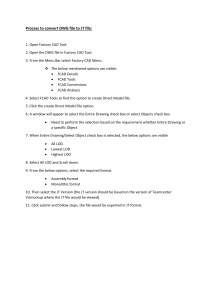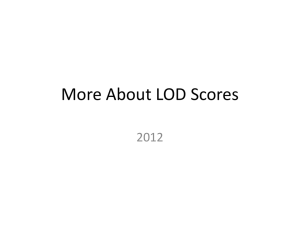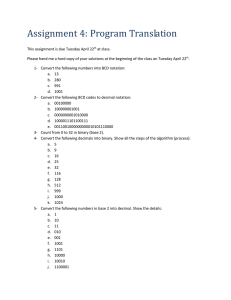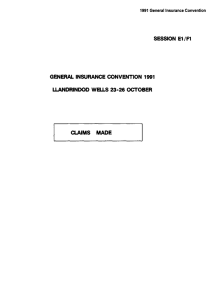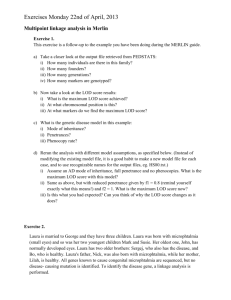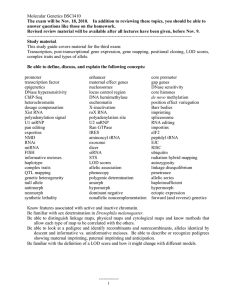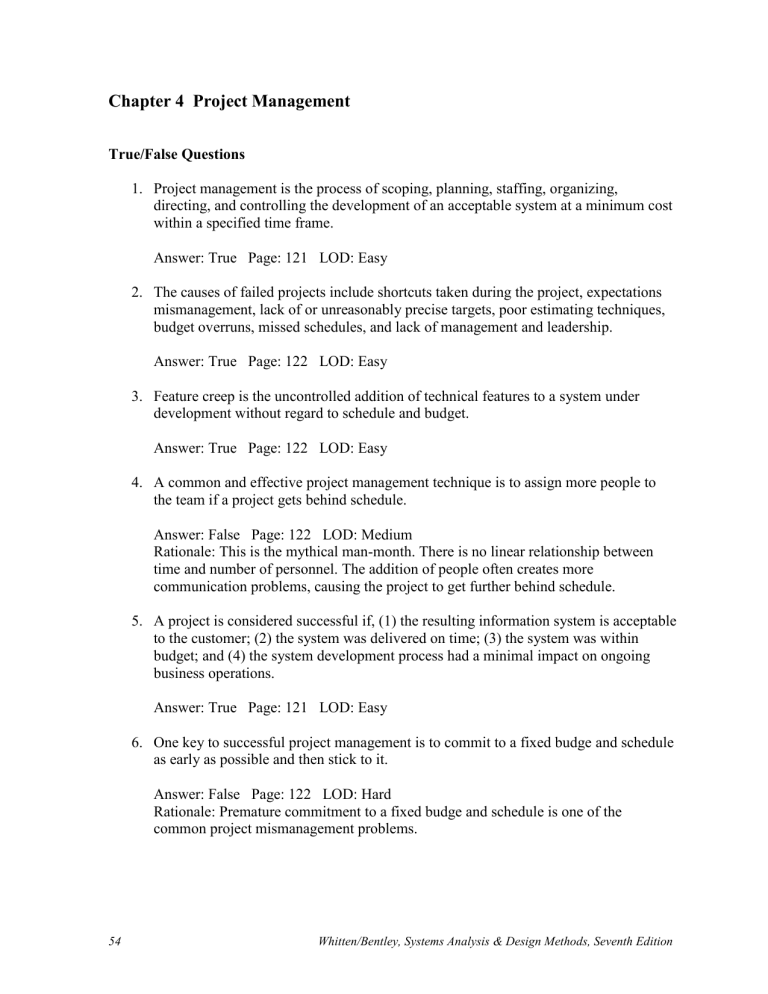
Chapter 4 Project Management True/False Questions 1. Project management is the process of scoping, planning, staffing, organizing, directing, and controlling the development of an acceptable system at a minimum cost within a specified time frame. Answer: True Page: 121 LOD: Easy 2. The causes of failed projects include shortcuts taken during the project, expectations mismanagement, lack of or unreasonably precise targets, poor estimating techniques, budget overruns, missed schedules, and lack of management and leadership. Answer: True Page: 122 LOD: Easy 3. Feature creep is the uncontrolled addition of technical features to a system under development without regard to schedule and budget. Answer: True Page: 122 LOD: Easy 4. A common and effective project management technique is to assign more people to the team if a project gets behind schedule. Answer: False Page: 122 LOD: Medium Rationale: This is the mythical man-month. There is no linear relationship between time and number of personnel. The addition of people often creates more communication problems, causing the project to get further behind schedule. 5. A project is considered successful if, (1) the resulting information system is acceptable to the customer; (2) the system was delivered on time; (3) the system was within budget; and (4) the system development process had a minimal impact on ongoing business operations. Answer: True Page: 121 LOD: Easy 6. One key to successful project management is to commit to a fixed budge and schedule as early as possible and then stick to it. Answer: False Page: 122 LOD: Hard Rationale: Premature commitment to a fixed budge and schedule is one of the common project mismanagement problems. 54 Whitten/Bentley, Systems Analysis & Design Methods, Seventh Edition Chapter 4 Project Management 7. Over-optimism is the tendency for systems analysts and project managers to fail to recognize that project slips in one phase or activity can cause corresponding slips in many other phases and activities, and contribute to cost overruns. Answer: True Page: 122 LOD: Easy 8. If the project's importance changes during the project, or if the management or the business reorganizes, projects should be reassessed for compatibility with those changes and their importance to the business. Answer: True Page: 122-123 LOD: Easy 9. Cost overruns are not a reason for project failure. Answer: False Page: 121 LOD: Easy Rationale: Cost overruns are a reason for project failure 10. A Gantt chart is a simple horizontal bar chart that depicts project tasks against a calendar. Answer: True Page: 125-127 LOD: Easy 11. Each bar on a Gantt chart represents a named project task. Answer: True Page: 125-127 LOD: Easy 12. Scope defines the boundaries of a project. Answer: True Page: 130 LOD: Easy 13. Planning identifies the required tasks to complete the project based on the project goal. Answer: True Page: 146 LOD: Easy 14. The project schedule should be developed with an understanding of the required tasks, task duration, and task prerequisites. Answer: True Page: 125 LOD: Easy Whitten/Bentley, Systems Analysis & Design Methods, Seventh Edition 55 Chapter 4 Project Management 15. The project schedule should be developed based on the desired due date for project completion based on management decree. Answer: False Page: 125 LOD: Medium Rationale: The project schedule should be developed with an understanding of the required tasks, task duration, and task prerequisites. 16. GANTT is an acronym that stands for Group Activity Network Time Table. Answer: False Page: 125 LOD: Medium Rationale: Gantt is the last name of the inventor of the Gantt chart. PERT is an acronym that stands for Project Evaluation and Review Technique. 17. A project manager must demonstrate people management skills to coordinate, delegate, motivate, advise, appraise, and reward team members. Answer: True Page: 125 LOD: Easy 18. The project manager must monitor and report progress against goals, schedule, and costs, and make appropriate adjustments when necessary. Answer: True Page: 125 LOD: Easy 19. A Gantt chart is a graphical network model that depicts a project's tasks and the relationships between those tasks. Answer: False Page: 125 LOD: Medium Rationale: A PERT chart is a graphical, network model that depicts a project's tasks and the relationships between those tasks. A Gantt chart is a simple horizontal bar chart that depicts project tasks against a calendar. 20. PERT charts were developed to make clear the interdependence between project tasks. Answer: True Page: 125 LOD: Easy 21. Gantt charts clearly show the overlapping tasks, that is, the tasks that can be performed at the same time. Answer: True Page: 125-127 LOD: Easy 56 Whitten/Bentley, Systems Analysis & Design Methods, Seventh Edition Chapter 4 Project Management 22. Some project management competencies cannot be taught in a class but must be learned through business experience. Answer: True Page: 123-124 LOD: Medium 23. Rapid application development (RAD) is a strategy wherein all project stakeholders participate in a short duration project management workshop, which results in a consensus agreement on the project scope, schedule, resources, budget and quality. Answer: False Page: 127 LOD: Medium Rationale: Joint project planning (JPP) is a strategy wherein all project stakeholders participate in a short duration project management workshop, which results in a consensus agreement on the project scope, schedule, resources, and budget. 24. A statement of work is a narrative description of the work to be performed as part of a project. Answer: True Page: 130 LOD: Easy 25. A PERT chart depicts the WBS or Work Breakdown Structure. Answer: False Page: 130 LOD: Medium Rationale: A WBS is a hierarchical decomposition of the project into phases, activities, and tasks. A PERT chart is a non-hierarchical chart of the tasks, their durations, and their interdependences. 26. The answers to five basic questions influence the negotiation of project scope: (1) product; (2) quality; (3) time; (4) cost; and (5) resources. Answer: True Page: 130 LOD: Easy 27. Scope defines both the boundaries of what is included in the system, as well as what is considered outside of the project. Answer: True Page: 120 LOD: Easy Whitten/Bentley, Systems Analysis & Design Methods, Seventh Edition 57 Chapter 4 Project Management 28. Joint project planning (JPP) is a hierarchical decomposition of the project into phases, activities and tasks. Answer: False Page: 130 LOD: Medium Rationale: A joint project planning (JPP) is where all project stakeholders participate in a workshop to achieve consensus on the project scope, schedule, resources, and budget. A work breakdown structure (WBS) is a hierarchical decomposition of the project into phases, activities, and tasks. 29. Optimistic duration is the estimation of the maximum amount of time that it would take to perform a task. Answer: False Page: 133 LOD: Medium Rationale: Optimistic duration is the estimation of the minimum amount of time that it would take to perform a task. Pessimistic duration is the estimation of the maximum amount of time that it would take to perform a task. 30. Optimistic duration is the estimation of the minimum amount of time that it would take to perform a task. Answer: True Page: 133 LOD: Easy 31. Pessimistic duration is the estimation of the minimum amount of time that it would take to perform a task. Answer: False Page: 133 LOD: Medium Rationale: Optimistic duration is the estimation of the minimum amount of time that it would take to perform a task. Pessimistic duration is the estimation of the maximum amount of time that it would take to perform a task. 32. Elapsed time measures the actual amount of time that it takes to complete a task, taking into account that workers cannot possibly perform at 100% efficiency, and that interruptions increases the amount of time it takes from start to finish to complete a task. Answer: True Page: 133 LOD: Medium 33. The expected duration of a task is the estimation of how much time will be required to perform the task by taking into account potential interruptions or delays that are likely to occur. Answer: True Page: 133 LOD: Easy 58 Whitten/Bentley, Systems Analysis & Design Methods, Seventh Edition Chapter 4 Project Management 34. Milestones have no duration. Answer: True Page: 134 LOD: Medium 35. Forward scheduling establishes a project start date and then schedule forward from that date. Based on the planned duration of required tasks, their interdependencies and the allocation of resources to complete those tasks, a projected project completion date is calculated. Answer: True Page: 135 LOD: Easy 36. Forward scheduling establishes a project deadline forward into the future, and then schedules backwards from that date. Answer: False Page: 135 LOD: Medium Rationale: Backward scheduling establishes a deadline date, and then schedules backwards from that date. Forward scheduling establishes a start date, and then schedules forward from that date. 37. The availability of resources, especially people and facilities, can significantly alter the project schedule. Answer: True Page: 136 LOD: Easy 38. Resource leveling is a strategy used to correct resource over-allocations by some combination of delaying or splitting tasks. Answer: True Page: 138 LOD: Easy 39. The critical path for a project is that sequence of dependent tasks that have the largest sum of most likely durations. The critical path determines the earliest possible completion date of a project. Answer: True Page: 138 LOD: Easy 40. The critical path for a project is that sequence of dependent tasks that have the shortest sum of pessimistic durations. The critical path determines the latest possible completion date of a project. Answer: False Page: 138 LOD: Medium Rationale: The critical path for a project is that sequence of dependent tasks that have the largest sum of most likely durations. The critical path determines the earliest possible completion date of a project. Whitten/Bentley, Systems Analysis & Design Methods, Seventh Edition 59 Chapter 4 Project Management 41. The slack time available for any non-critical task is the amount of delay that can be tolerated between the starting time and completion time of a task without causing a delay in the completion date of the entire project. Answer: True Page: 138 LOD: Easy 42. The inefficiency of workers is known as slack time. Answer: False Page: 138 LOD: Medium Rationale: Slack time is the amount of delay that can be tolerated between the starting time and the completion time of a task without causing a delay in the completion date of the project. 43. It is uncommon for project scope to grow out of control even when a properly completed statement of work was agreed on early in the planning process. Answer: False Page: 141 LOD: Easy Rationale: It is common. 44. When a properly completed statement of work is agreed upon at the start of the planning process, it is unlikely that changes in project scope will occur. Answer: False Page: 141 LOD: Medium Rationale: It is not uncommon for project scope to grow out of control even when a properly completed statement of work was agreed on early in the planning process. 45. Change is frequently a point of contention between the customer and the information systems organization, because they disagree on whether a particular function is a change or a part of the initial agreement. Answer: True Page: 141 LOD: Easy 46. An expectations management matrix shows that if project scope changes then cost and/or schedule must also change. Answer: True Page: 143-147 LOD: Easy 47. Once management has committed to a project, it is not possible for them to change the funding allocated to the project, or to change the deadline of the project. Answer: False Page: 142 LOD: Medium Rationale: A project can change because management can reduce the funding for the project or imposes an earlier deadline than originally agreed upon. 60 Whitten/Bentley, Systems Analysis & Design Methods, Seventh Edition Chapter 4 Project Management 48. An expectations management matrix is a tool for helping management understand the dynamics and impact of changing project parameters such as cost, schedule, scope and quality. Answer: True Page: 143 LOD: Easy 49. "Identify Business Requirements" is an example of a milestone. Answer: False Page: 132 LOD: Medium Rationale: A milestone is an event that signifies the completion of a major project deliverable. Identify Business Requirements would be an activity or task leading up to the requirements statement milestone. Multiple Choice Questions 50. Which of the following is NOT a project management cause of failed projects? A) shortcuts taken during the project B) lack of or imprecise targets C) inadequate systems analysis and design tools D) budget overruns E) schedule delays Answer: C Page: 122-123 LOD: Medium 51. Which of the following is NOT a basic function of a project manager? A) controlling B) programming C) scheduling D) directing E) planning Answer: B Page: 124-125 LOD: Easy 52. Which of the following functions of the project manager is the most difficult and important function? A) planning B) organizing C) directing D) controlling E) staffing Answer: D Page: 125 LOD: Medium Whitten/Bentley, Systems Analysis & Design Methods, Seventh Edition 61 Chapter 4 Project Management 53. Which of the following is a simple horizontal bar chart that depicts project tasks against a calendar? A) PERT chart B) Bar chart C) WBSt D) Line chart E) Gantt chart Answer: E Page: 125-127 LOD: Easy 54. Which of the following establishes a project start date and then schedules forward from that date? A) end scheduling B) remote scheduling C) forward scheduling D) reverse scheduling E) none of these Answer: C Page: 135 LOD: Medium 55. Which of the following establishes a project deadline and then schedules backward from that date? A) end scheduling B) remote scheduling C) reverse scheduling D) forward scheduling E) none of these Answer: C Page: 135 LOD: Medium 56. The process of scoping, planning, staffing, organizing, and controlling the development of an acceptable system at a minimum cost within a specified time frame is: A) Project Management B) Process Management C) Expectations Management Matrix D) Statement of Work E) None of these Answer: A Page: 121 LOD: Medium 62 Whitten/Bentley, Systems Analysis & Design Methods, Seventh Edition Chapter 4 Project Management 57. An ongoing activity that documents, manages the use of, and improves an organization's chosen methodology for systems development is: A) Project Management B) Process Management C) Expectations Management Matrix D) Statement of Work E) None of these Answer: B Page: 143ru LOD: Medium 58. A narrative description of the work to be performed as part of a project is: A) scope statement B) statement of work C) project definition D) project overview E) all of these Answer: E Page: 130 LOD: Medium 59. A strategy wherein all project stakeholders participate in a multiple-day workshop to achieve consensus on project scope, schedule, resources and budget is: A) Total Quality Management B) Stakeholder's Meeting C) Joint Project Planning D) Capability Maturity Planning E) none of these Answer: C Page: 127 LOD: Medium 60. Which of the following is NOT one of the five basic questions that influence project scope?: A) what product is wanted B) the efficiency of each of the team members C) when should the product be delivered D) what resources are available for the project E) none of these Answer: B Page: 130 LOD: Medium Whitten/Bentley, Systems Analysis & Design Methods, Seventh Edition 63 Chapter 4 Project Management 61. Elapsed time takes into account which of the following factors? A) people cannot work at 100% efficiency B) people experience interrupts such as phone calls, visitors or other activities C) people need lunch breaks D) people possibly participate in other non-project related work E) all of these Answer: E Page: 133 LOD: Medium 62. Which of the following is the estimate of the minimum amount of time it would take to perform a task? A) minimal duration B) optimistic duration C) pessimistic duration D) expected duration E) earliest completion Answer: B Page: 133 LOD: Medium 63. Which of the following is the estimate of the longest amount of time it would take to perform a task? A) maximum duration B) optimistic duration C) pessimistic duration D) expected duration E) latest completion Answer: C Page: 133 LOD: Medium 64. Which of the following is the estimate of the time that will be needed to perform the task? A) estimated duration B) optimistic duration C) pessimistic duration D) expected duration E) none of these Answer: D Page: 133 LOD: Medium 64 Whitten/Bentley, Systems Analysis & Design Methods, Seventh Edition Chapter 4 Project Management 65. Which of the following is considered a project resource? A) people B) services C) facilities D) money E) all of these Answer: E Page: 136 LOD: Easy 66. Which of the following is NOT one of the guidelines for selecting and recruiting team members? A) recruit talented and highly motivated people B) select the best task for each person C) keep the team size as small as is reasonable to minimized communication overhead and difficulties D) promote harmony by selecting team members who will complement and work well with each other E) Make the team as large as possible to assure that you have the resources to complete the project within the schedule. Answer: E Page: 138 LOD: Hard 67. Which of the following is the sequence of dependent tasks that have the largest sum of most likely durations? A) optimistic duration B) pessimistic duration C) critical path D) slack time E) none of these Answer: C Page: 138 LOD: Medium 68. Which of the following is NOT shown on a PERT chart? A) scheduled start date B) actual start date C) task name D) estimated duration E) intertask dependencies Answer: D Page: 126 LOD: Medium Whitten/Bentley, Systems Analysis & Design Methods, Seventh Edition 65 Chapter 4 Project Management 69. Which of the following is the amount of delay that can be tolerated by a non-critical task without causing a delay in the completion date of the entire project? : A) optimistic duration B) pessimistic duration C) critical path D) slack time E) none of these Answer: D Page: 138 LOD: Hard 70. Which of the following is NOT a likely reason for a change in project scope?: A) availability of better technology B) users or management want the system to do more than originally requested C) the expectations management matrix is correct D) the funding for the project has been reduced E) none of these Answer: C Page: 142 LOD: Hard 71. A tool for helping management understand the dynamics and impact of changing project parameters such as cost, schedule, scope and quality is: A) total quality management B) project management C) joint project planning D) expectations management matrix E) none of these Answer: D Page: 143 LOD: Medium 72. Which of the following questions should NOT be answered during a project review?: A) Which of the project team members are the most compatible? B) Did the project come in under budget? C) Did the project come in on schedule? D) Did the final product meet or exceed user expectations? E) all of these are appropriate questions to be answered during a project review Answer: A Page: 149 LOD: Easy 66 Whitten/Bentley, Systems Analysis & Design Methods, Seventh Edition Chapter 4 Project Management 73. The common techniques for estimating include: A) decomposition B) COCOMO C) function points D) resource leveling E) all of these Answer: D Page: 133 LOD: Hard 74. Which of the following is NOT one of the 10 hints for project leadership? A) praise in public, criticize in private B) explain and show, rather than do C) don't rely just on status reports D) keep "fudge" time in the schedule by not communicating "real" deadlines to team members E) be consistent Answer: D Page: 139 LOD: Medium Fill in the Blank Questions 75. ________________ is the unexpected growth of user expectations and business requirements for an information system as the project progresses. Answer: Scope creep Page: 122 LOD: Medium 76. List the basic functions of a project manager. Answer: Scoping the project, Planning project tasks and staffing the project team; Estimating task requirements from time, resource and skills points of view; Organizing and scheduling the project effort; Directing and controlling the project; Closing and evaluating the project at its conclusion Page: 124-125 LOD: Medium 77. ________________ is a graphical model that depicts a project as a series of events and milestones that are dependent on one another. Answer: PERT (Project Evaluation and Review Technique) Page: 125 LOD: Medium Whitten/Bentley, Systems Analysis & Design Methods, Seventh Edition 67 Chapter 4 Project Management 78. ________________ is the uncontrolled addition of technical features to a system under development without regard to schedule and budget. Answer: Feature creep Page: 122 LOD: Medium 79. ________________ is an ongoing activity that documents, manages the use of and improves an organization's chosen methodology for systems development. It is concerned with the activities, deliverables, and quality standards to be applied to all projects. Answer: Process management Page: 121 LOD: Medium 80. A ________________ is a hierarchical decomposition of the project into phases, activities, and tasks. Answer: work breakdown structure Page: 130 LOD: Medium 81. ________________ are events that signify major accomplishments or events during a project. Answer: Milestones Page: 132 LOD: Easy 82. The ________________ available for any task is equal to the difference between the earliest and latest completion times. Answer: slack time Page: 138 LOD: Medium 83. ________________ stands for project evaluation and review technique. Answer: PERT Page: 125 LOD: Easy 84. ________________ establishes a project start date and then schedules forward from that date. Answer: Forward scheduling Page: 135 LOD: Hard 85. What are the four types of intertask dependencies that determine the start or completion of tasks? Answer: Finish to Start (the finish of one task triggers the start of another task); Start to Start (the start of one task triggers the start of another task); Finish to Finish (two tasks must finish at the same time); and Start to Finish (the start of one task signifies the finish of another task). Page: 134 LOD: Hard 68 Whitten/Bentley, Systems Analysis & Design Methods, Seventh Edition Chapter 4 Project Management 86. The project management causes of ___________________________ include shortcuts taken during the project, expectations mismanagement, lack of or unreasonably precise targets, poor estimating techniques, budget overruns, missed schedules, and lack of management and leadership. Answer: failed projects Page: 122-123 LOD: Easy 87. _________________ is a strategy for correcting resource overallocations. Answer: resource leveling Page: 138 LOD: Easy 88. A project is considered ______________________ if, (1) the resulting information system is acceptable to the customer; (2) the system was delivered on time; (3) the system was within budget; and (4) the system development process had a minimal impact on ongoing business operations. Answer: successful Page: 121 LOD: Medium 89. A ________________________ is a simple horizontal bar chart that depicts project tasks against a calendar. Answer: Gantt chart Page: 125 LOD: Easy 90. _____________________ defines the boundaries of a project. Answer: Scope Page: 130 LOD: Medium 91. ________________________ identifies the required tasks to complete the project based on the project goal. Answer: Planning Page: 124 LOD: Medium 92. A _____________________________ must demonstrate people management skills to coordinate, delegate, motivate, advise, appraise, and reward team members. Answer: project manager Page: 125 LOD: Medium 93. PERT charts were developed to make clear the _____________________ between project tasks before those tasks are scheduled. Answer: interdependence Page: 125 LOD: Medium Whitten/Bentley, Systems Analysis & Design Methods, Seventh Edition 69 Chapter 4 Project Management 94. ____________________________ is a strategy wherein all project stakeholders participate in a short duration project management workshop, which results in a consensus agreement on the project scope, schedule, resources, and budget. Answer: Joint project planning (JPP) Page: 127 LOD: Hard 95. _______________________________ is the estimated minimum amount of time needed to complete a task. Answer: Optimistic duration Page: 133 LOD: Hard 96. ________________________ measures the actual amount of time that it takes to complete a task, taking into account that workers cannot possibly perform at 100% efficiency, and that interruptions increases the amount of time it takes from start to finish to complete a task. Answer: Elapsed time Page: 133 LOD: Medium 97. The __________________________________ is the sequence of dependent tasks that determines the largest sum of most likely durations. Answer: critical path Page: 138 LOD: Medium 98. The ____________________________________ available for any non-critical task is the amount of delay that can be tolerated between the starting time and completion time of a task without causing a delay in the completion date of the entire project. Answer: slack time Page: 138 LOD: Medium 99. Give some reasons for project changes. Answer: (1) an omission occurred in the initial scope definition; (2) a misunderstanding occurred in the initial scope definition whereby the desired product is actually more complicated than originally communicated or perceived; (3) external events such as government regulations create new requirements; (4) organizational changes, such as mergers, acquisitions and partnerships that create new business problems and opportunities. Page: 142 LOD: Hard 100. A(n) __________________________________________ is a tool for helping management understand the dynamics and impact of changing project parameters such as cost, schedule, scope and quality. Answer: expectations management matrix 70 Page: 143 LOD: Medium Whitten/Bentley, Systems Analysis & Design Methods, Seventh Edition
